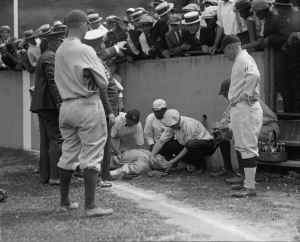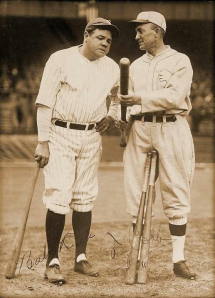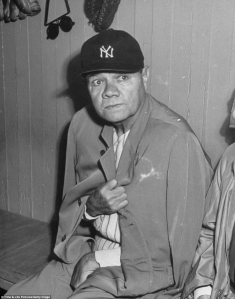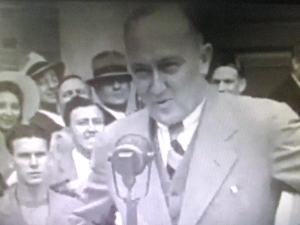TY COBB: BASEBALL’S PREMIER PLAYER EARNED MOST PRESTIGIOUS DISTINCTION AS FIRST HALL OF FAMER, DISSED BY MODERN LEADERSHIP
He Stood Alone As Player And First Baseball Immortal And Will Now Go Uncelebrated By Institution Established For Specific Preservation.
by Wesley Fricks, National Ty Cobb Historian
Tampa, Fl June 14, 2014 – “This is a great day in my life. I am very happy to be here,” said Ty Cobb after walking out in front of the crowd at Cooperstown that consisted of ten thousand or more at the opening dedication ceremony for the National Baseball Hall of Fame and Museum on June 12, 1939. And he continued, “I feel greatly honored; it’s a privilege to be here.”
“THERE IS NOTHING GOING ON FOR TY COBB,” – Anonymous representative for the National Baseball Hall of Fame and Museum, Cooperstown, New York.
On the 75th Anniversary of the dedication of the Baseball Hall of Fame, no one there is interested in the man who received a near perfect voting score with 222 of 226 votes from the Base Ball Writers Association. He received more votes than Walter Johnson, Christy Mathewson, Honus Wagner and Babe Ruth.
He was considered the pinnacle of players by those who witnessed his feats, but now, they no more than want to barely mention his name in a tube with others.
“We don’t have anything special for Ty Cobb,” remarked John Odell, Curator of History and Research, National Baseball Hall of Fame & Museum, “Today we open up the Babe Ruth exhibit.”
What a shameful and disgraceful insult to Ty Cobb. How could you not honor Ty Cobb on the 75th Anniversary of the opening of the Museum? He was
only the greatest performer in baseball history and the Museum’s first honored inductee.
Babe Ruth?
But Babe Ruth – that’s a different story. He set a homerun record of 60 homeruns in a season in 1927 and the lifetime total at 714, but what many don’t know is that he was also a terrible louse in character. No one cared for the distraction that he caused on the field and in the locker room. The terrible conduct that carried him through his twenty-one seasons and ultimately ended his controversial career in 1935.
Here is a sketch of his contentious legacy in baseball.
Babe Ruth was suspended indefinitely in 1917 for punching out an umpire Clarence “Brick” Owens on June 25, 1917.
In May 1919, while a member of the Boston Red Sox, Ruth had a run-in with Ed Barrow, of all people, and was suspended from the team, citing training rules. This could have, along with other indiscretions that year, lead to the real reason Ruth was sold to the New York Yankees after the season had closed and not because of any great feats.
On January 6, 1920, Boston Red Sox Owner, Harry Frazee explained the sale this way, “I think they are taking a gamble. With this money the Boston club can now go into the market and buy other players and have a stronger and better team in all respects than we would have had if Ruth had remained with us.”
Sometime in 1920, the Babe has an extramarital affair with a young girl named Juanita Jennings from California. Miss Jennings gets pregnant and gives birth to Dorothy Ruth. She was later adopted by Babe and Helen to eliminate confusion and public opinion. One day out of the blue, Ruth shows up at the park and introduces Dorothy as his daughter. Babe often gave inaccurate statements about the child until she was no longer part of reporter’s line of questions.
Ruth was jailed for speeding on June 9th, 1921 and spent four and one half hours in a cell. It was his second offense for such crime and the Judge threatened to take his license if he was caught a third time.
In October 1921, Ruth created more drama with the fans as he nurtured a big scratch on his left arm near the elbow. In addition, he had bandages on both legs above the knees. He was playing up to the sympathies of the crowds, but in reality, he had fallen the night before from his episodes of inebriation.
On December 5th, 1921, Judge Landis ruled that Babe Ruth and two other Yankee players had violated Major League Baseball rules by barnstorming not sanctioned by the league. As a result, Ruth and company were suspended for 38 days of the 1922 season and forfeited their 1921 World Series money.
Total loss for Babe Ruth, $3,362.00 for losing World Series and nearly $7,000.00 in salary for the 6 weeks in 1922 that the players were suspended. Total approximated loss – $10,362.00.
Later in 1922, Ruth gets into an argument with an Umpire Dineen over a call on another player. Gets tossed from the game, threatens the umpire, invites him to a fist fight under the stands. Makes a threat on the umpires well being, “The next time you put me out of the game,” screamed Ruth, “I’ll put you out for life, even if it keeps me out for life.”
He gets suspended and comes back the next game and repeats argument with same umpire before first suspension is given. For his first offense – 3 days, second offense – 2 more days for a total of 5 days suspension for arguing with same umpire. After suspension is handed down, he then goes up to the same umpire before a game and asks the umpire, “Don’t you think I got a bad deal?” He now takes role of victim which he had established as a pattern for himself.
In March 1923, Babe Ruth was sued for $50,000 for getting an eighteen year old orphan girl pregnant through an inappropriate relationship. He started out taking her for a ride in his person automobile four or five times a week while he was married to his first wife Helen Ruth.
When the news was made public, Babe Ruth went into defense mode. He quickly hired Hyman Bushel, a Russian attorney from Manhattan to defend the charges in court. Ruth was not going to admit his unfaithfulness to his wife again and his immoral act on another innocent young girl.
His lawyer said that Ruth never saw Dolores Dixon in his life. In separate statement by Ruth’s wife, she explained how the Ruth family was introduced to the little girl in the spring of 1922.
The Babe was lying!
She stated in a formal complaint to the county clerk’s office that Ruth “with force and violence, made indecent assaults upon her.” Whereas, as a result, Miss Dixon became pregnant and the rich and famous Babe Ruth never cared for his illegitimate child. Both of which are considered criminal charges under today’s rule and standards of law. A behavior of such today that would carry a jail sentence in any state.
For the Yankee player it was all about babes and booze. “I’ll promise to go easier on drinking and to get to bed earlier, but not for you, fifty thousand dollars or two-hundred and fifty thousand dollars, will I give up women. They’re too much fun,” said Babe Ruth.
In April 1924 against the Washington club, Ruth was put out of the game by Umpire Billy Evans for throwing his bat in the air because he did not like a called third strike as the Yankees were losing 7-2.
On Saturday July 5, 1924, Ruth was recovering from a long Friday night of drinking and partying at his favorite hot spot, but he managed to spend an hour that morning in Camp Meade, Maryland batting out autographed balls to the summer camp boys. By game time, the homerun champ was worn and depleted.
In the first inning of a double header, Ruth was chasing down a fly ball in foul territory and in a drunken state slammed into the concrete wall. He was knocked out for what seemed to be five long minutes. After tending to him and getting him back on his feet, the player refused orders to sit out. He was noticeably lame for the rest of the game as noted by the fans. It was noted that he visibly had the “shakes.”

Ruth falls up against the concrete wall trying to field a fly ball. He was out for five minutes as the team trainer works on him.
Later that same year in September, Ruth quit the game in the seventh inning complaining of a sore arm.
In Asheville, North Carolina in April 1925, Ruth collapsed again and remained out from the train to the hotel. Manager Huggins immediately sent Ruth back home to New York where he administered his own medicine – whatever that might be.
He had just gotten over a case of the flu and suffered a sore finger that kept him out of the game during spring training at St. Petersburg. He even complained about train sickness as he traveled through Tennessee and North Carolina. Huggins expected Ruth to be active in time for the opening day, but he did not play his first game of the season until June 1st.
After other indiscretions that year, Manager Miller Huggins, Secretary Ed Barrow and President, Colonel Jacob Ruppert, all had enough of Babe Ruth. Without even consulting with the ownership, Huggins announced on August 29th, 1925 the most egregious fine on Babe Ruth – a record $5,000 and an indefinite suspension. The reason you asked? “Misconduct” off the field was the official explanation. Huggins refused to give out information or answer questions about the disciplinary actions hand out by the Yankees’ organization.
When Huggins was pressed and asked by a reporter does “misconduct” off the field mean drinking? Huggins replied, “Of course, it means drinking,” replied the Yankee skipper, “and it means a lot of other things.”
Huggins did add some details of how the situation escalated as it did. “When he started playing on the first of June, he was on probation. Bound to take care of himself physically and live up to the rules of club discipline,” said Huggins. “He has forgot about all these restrictions!”
When players began to inquire of Ruth’s whereabouts, he was back at the Buckingham Hotel in a jovial mood, not appearing to worry about his troubles and packing for New York.
But instead of going to New York, he canceled his train reservation and headed for Chicago to plead his case as the victim. “Huggins in making me the ‘goat’ for the rotten showing of the team,” said Ruth. But Huggins was backed by Ruppert, Barrow and American League President, Ban Johnson.
Acting like an overgrown baby, Ruth swore, “If Huggins is the manager, I am through with the Yankees.” He furthered his threats with, “Either he quits or I quit.”
Ruth had already been fined once since June 1. He was fined $1,000 by Huggins for violating the 1 am team curfew and staying out all night drinking. Huggins remitted the fine and gave the Babe another chance.
Ruth suspected that it was because his “falling off” in his performance that led Huggins to such a drastic measures. But Ruth had his usual excuse, “I know why I have fallen off, I have tried to play before I was fully recovered from my recent illness,” complained Ruth. “A man can’t jump out of a hospital cot into a baseball uniform and hit .350.”
Ruth cared more about blaming Huggins than taking responsibility himself. He accused Huggins of giving Washington a “pennant and a world’s championship by trading Peckinpaugh,” diverting attention away from the real issue to point to the Yankees’ managerial imperfections. “He took Shocker from the Browns and gave away Bush, Gaston and Giard,” he claimed, “The only reason the Browns are in the first division.”
Less than two weeks, Ruth was sued in court because his dog killed one of his neighbor’s cow and the Yankee player refuse to replace the animal.
Ruth was jailed on Fishing out of season on June 12, 1926 in Howell, Michigan – a warrant issued.
In September 1926, Ruth and teammate, Mark Koenig got into a fisticuff in the dugout and were separated by police during a lopsided lost to Baltimore 18-9. The celebrated player failed to get a hit in 5 times at bat and sent a disappointed group from St. Mary’s Industrial school home with a sour taste on their tongues.
Helen, Ruth’s first wife, was burned in a house fire on January 11th, 1929. Her will was executed a couple of weeks later and it barred the Babe from inheriting any of her assets which was believed to exceed $50,000 and that was not counting property she owned in Massachusetts. Her will bequeathed to Ruth $5 in lieu of and in bar of every right and interest in her estate the provision explained. She essentially disinherited him for his adultery with Juanita Jennings Ellias in 1920 and Miss Dixon in 1922 and probably other women not yet revealed.
Injury, and his complaints of such, was the subject of continuous controversy again on the week of July 4, 1930. Ruth had been out most of the week and was pressured by team leadership to play on the 3rd. He went 0 for 2 with a fly out to centerfield and two miserly and wretched dribbles in the infield. Results? Yankees lose again!
When Ruth was offered a contract for less than what he made in 1932, he lashed back at the management of the Yankees, “I will retire from baseball before I will sign a contract that calls for that much,” said the 37 year old slugger. “I believe that I am worth more to the Yankees than $50,000.”
After kicking up as much dust as he could, the once great player succumbed to the changing demands of the club. With the likes of Lou Gehrig, Sam Chapman and Bill Dickey in the lineup, the Yankees did not need to depend on the roller coaster exploits of the clownful Babe.
One day he is pelting out two homeruns a game and the next week he is striking out a score of times in a series or laying down heavy dribbles on the infield.
The Babe Ruth circus act settled for a stingy adjusted amount of $52,000 for 1933.
In September 1934, Ruth sought for more sympathy as he made public his intentions on quitting the game at season’s end. “I am getting too old for the game,” he said sourfully, “and I know it.”
“I’ve seen too many players try to look frisky when they should be home playing with their grandchildren,” he said thinking back over his career. “I know enough to stop running when my legs feel tired.”
After an unhealthy and decayed ending with the Yankees, who let Ruth walk away freely, the Boston Braves offered the declining player “the greatest opportunity Ruth ever had.” Ruth signed with the Boston Braves as a gate attraction, a side show and not as much for his playing ability. He was even named vice president and was allowed to be informed of any dealings with the players, but ultimately, he was clown-dressed to draw gate receipts.
This setup almost did not survive through the month of May 1935 before Ruth was ready to give up and call it quits. “I’m all washed up,” the rescinding Ruth said complaining in disgust. “I will be asked to be put on the voluntary retiring list.”
On June 2, 1935, Babe Ruth was fired from the Boston Braves which Owner Emil Fuchs cited as “strife in the Boston club’s office.” The once boy-wonder, who had been consumed by his deep desires to manage in Major League Baseball, was given his unconditional release. He never was affiliated with the game again, at least not in any official capacity. It was sad for him, but in reality, all the things that he did to baseball, to the game, had come back to haunt him in the end.
No one wanted him around and no one wanted him to manage in the big leagues.
His final strike came because another one of his injuries had prevented him from playing. While not the issue at hand, the team needed him to assist in selling 500 tickets in a deal set up by Manager Bill McKechnie and Fuchs, and Babe wanted to go to the “Welcome to Normandie” celebration in New York on that Tuesday night.
Again Ruth played victim saying that Fuchs had double-crossed him. In reality, Manager McKechnie asked for Ruth’s release several days before and Fuchs denied such. It was Babe Ruth’s act of selfishness that has slammed the door shut on his major league career in baseball. He got his way though, he attended his party, “Welcome to Normandie.”
To add salt to the injury, he was arrested on November 15th, 1935 for hit and run after colliding with another vehicle near the Queensboro Bridge and 60th Street.
The Babe’s reputation as a clean and lovable hero might need a tune up in the circles of baseball historians. The National Hall of Fame & Museum may want to consider revisiting the facts and get a more complete and comprehensive picture of Ruth if they wish to continue to the be the legitimate and honorable source for absolute accuracy and preservation of its history.
Nonetheless, the contrast between the two players has always created much debate with baseball fans everywhere.
I do not dislike Ruth as a player or as a person. I have already forgiven him for all of his indiscretions and imperfections. But to place him ahead of Ty Cobb would be as erroneous as taking a pacifier from an infant. Cobb far outreaches the Babe at play and off the field.
Ruth was as loose as a canon in just about every way and Cobb was a responsible, dependable gentleman that always followed through on his word. He never said a word that he did not mean and you could count on it.
On the field, Cobb was a record setter and led the way at bat and on the bases. He never allowed the fans to see him loafing or displaying incompetence. He was always promoting the great game of baseball.
Ruth was always looking for a way out. Pay me and let me get out of here. There always seemed to be a party waiting on me somewhere. His reckless energy constantly caused run-ins with teammates, umpires, ownership, and yes, even fans. The 1915 episode was one of the most bizarre occurrences and it happened again on March 21, 1920 where the fan pulled out a knife to back Ruth down. It happened again in 1922 when a fan called Ruth a bum.
The history of baseball and historical writers will have you believe that Ruth retired. This is simply a falsehood as Ruth was fired from his position with the Boston Braves and was given his unconditional release from the team.
And in further contrast, Major League Baseball wanted Ty Cobb till the very end.
When Cobb retired from the Detroit Tigers, scores of teams swarmed in with lucrative offers for the Georgia Peach to join company. The Browns tracked Cobb down in South Carolina’s low country for hours by horseback to train back to horseback.
The club that finally got his autograph gave him a blank check with the trust that he decides himself on the right price. It became the highest paid price in the game, but the terms were accepted and paid out.
Cobb was a strong drawing card, but more importantly, he produced timely results that helped his team achieve victory. He helped the Philadelphia Athletics build a pennant winner. Although Cobb retired from the game in 1928, Connie Mack’s team did win three straight pennants in 1929, 30 & 31 winning over 100 games each year. They won the World Series in 1929 & 1930.
Ty Cobb was a big part of those teams because of his effective hitting instructions. This is just one example of how he made a lasting impression on the game.
Finally, the last thing I can point you to is the wonderful record that Ty Cobb left for the record books.
Hey played in 3,033 games; got 4,191 base hits; stole 892 bases, got 12 American League batting titles; 9 consecutive American League batting titles; 96 single season stolen bases; 11,429 at bats; scored 2,245 runs; 23 consecutive seasons batting over .320; won the triple crown in 1909; most steals of home plate with 55; most season with 200 or more hits, 9; and an astounding lifetime batting average of .367.
He was also the very first player voted into the National Hall of Fame & Museum in Cooperstown, New York in 1936. He received more votes than Walter Johnson, Christy Mathewson, Honus Wagner, and yes, Babe Ruth. Of 226 writers eligible to vote, Cobb received 222 votes for the first place selection etching out a 98.2 percent, another long standing record.
Beyond the reasonable doubt of any baseball fan, Ty Cobb stood alone as player and as the first baseball immortal and will should not go uncelebrated by the very institution sworn to uphold the time-honored preservation of the players that made baseball the greatest of all pastimes.
Ty Cobb was baseball’s premier player and earned the most prestigious distinction as the first Hall of Famer.


